Fact or fiction? The ascendancy of Romanticism in contemporary landscape painting in Australia
- Andrew McIlroy
- Dec 4, 2018
- 8 min read

It is hard to find anyone today who dislikes the art of J.M.W. Turner. But while his famous Romantic paintings figure prominently in many artists’ list of most admired works, Romanticism itself is not widely viewed today as in any way fashionable. However, recent scholarly work has opened up a new way of looking at Romantic art of the 18th and 19th centuries - both European and Colonial - affirming its significant influence on contemporary art practice.
Previous descriptions of Romanticism as basically expressionistic have oversimplified and underestimated how radically the Romantics transformed the relationship between art and its audience.
Without diminishing Romantic heterogeneity, the underlying appeal of Romanticism according to new thought relies less on the artist’s desire to arouse in their audience an awareness of the impulses society had encouraged them to suppress and to provoke self-criticism. Recognising this gives us clearer insight into the special emancipating role the Romantics gave to ‘imagination’.
It is this comprehensiveness that enables us to more fully understand why Romanticism has survived to feature as such a dominant influence.

J.M.W. Turner
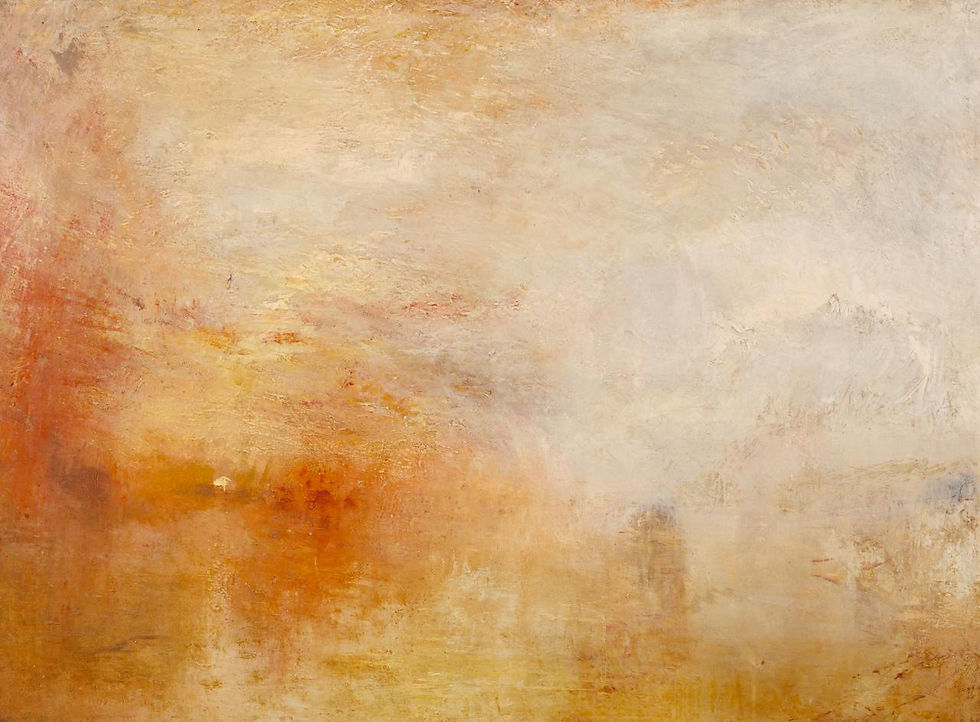
J.M.W. Turner, 'Sun Setting over a Lake' c1840 Photo: NGV
Realism has always been the mainstay of Romantic painting. Affirmed famously when Turner noted for his close observation of the landscape strayed into uncharted waters, adopting an imaginary aesthetic, to be heavily criticised by those blinded by their adherence to convention. Against this, Turner’s vision set him apart from many of his peers - who focused on sublime, landscapes mixed with feelings of terror and awe - as a true modernist.
Romanticism in my view rightly still holds an important place among contemporary Australian landscape art. It has never gone away. However, many modern-day artists laying claim to the ideas of the sublime and their appropriation in their work have failed to grasp its full potential.
Curator and author Simon Gregg in his 2011 survey work entitled ‘New Romantics: Darkness and Light in Australian Art’ heralds a “return to passion in art, and a return to atmosphere and awe”. Australian artists he says are engaging with the Romantic “themes of melancholic yearning, communion with nature, and the sublime”. Gregg ambitiously claims that “countless numbers” of artists (which he puts at 36) are “reinvigorating this movement” and evidence “a shift in the future course of Australian art”.

Curator and author Simon Gregg Photo: PGAV
But is this simply wishful-thinking, an attempt to place these works within a long tradition, in some way validate them, and ascribe a higher value than would otherwise be the case? Or is there something deeper going on; more encompassing than a mere “return to beauty”? Something more powerful than placing value on emotion and intuition over reasoning and intellect?
Gregg’s collection of artists is indeed noteworthy for their technical prowess and skillful use of atmosphere. But is this sufficient? Is there a broader vision that lifts them from the realm of historical landscape painters - placing them as true proponents of Romantic art – to justly propel them to the forefront of contemporary painting?
In a formidable list forming what he describes as a new wave of Romantic artists, Gregg includes artists William Breen, Chris Langlois, Jason Cordero, Kathryn Ryan, Sophia Szilagyi, Peter Daverington, Philip Wolfhagen, Joanna Logue, and Tony Lloyd.
In my view, these artists are worthy of the Romantic mantle, not least because they bring to their work what I call the “third element”.
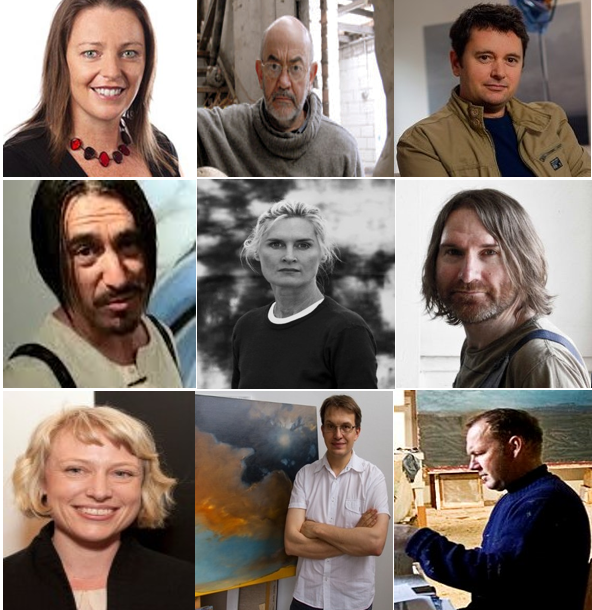
Top from left to right: Kathryn Ryan, Rick Amor, Chris Langlois, Peter Daverington, Joanna Logue, Tony Lloyd, Sophia Szilagy, Jason Cordero and Philip Wolfhagen
The two elements that often taken together give rise to a claim of competence in landscape painting are composition and technique. However, the vital third element, too often overlooked by artists chasing a Romantic aesthetic, is ‘meaning’. The practice of proficiently ‘painting what you see’ in the landscape is not sufficient for great Romantic art. A great landscape painting must imaginatively tell a story that resonates with the audience. A painting in my view simply misses the mark without all three elements.
I cannot agree with Gregg’s contention that a “new wave of Romantic artists” witnesses “a return to passion in art, and a return to atmosphere and awe”. This is too one-dimensional an approach, and can give rise to highly stylised or derivative art – perhaps even to a point where such gravitas is only ascribed to a painting as an afterthought. Romanticism represents more and runs deeper than that.
Among the artists pointed to by Gregg, there are however contemporary painters who combine all three essential elements - some more successfully than others. They do more than as Gregg argues, “echo Romanticism”.
Rick Amor
Although Rick Amor cannot in this context be categorised as a ‘New Romantic’, he remains one of the most highly regarded and important Romantic Australian artists of the last 100 years. Amor's paintings are imbued with potent symbolism and a majestic, poetic quality. Amor's play with light and shadows and his meticulous, draftsman-like use of depth of field in his paintings - particularly in his urban landscapes - bring a sense of tension, disquiet and mystery that intimates an array of meanings.
William Breen
William Breen’s thoughtful landscape paintings, suffused in atmospheric light, are a testimony to his skilled observation, understanding of classical composition and adroit use colour. Breen’s imagery “transcends the banal, hectic truth of the world”, transporting the viewer to a mystical place.
William Breen describing his work squarely places himself at the centre of Romantic art today,
The images echo a state of suspended animation, when everything slows down to a point where one can appreciate the contemplative nature of a world in balance, a world where everything is in its right place: an ideal vision. Although each painting is an intuitive ‘moment of clarity’, there is also a nostalgic quality, a half remembered past. The scenes are suspended in time and space in an emotive architectural landscape. Bathed in a diffused atmospheric light, the meditative nature of the urban image transcends the banal or familiar, into something sublime.
(Flinders Lane Gallery, Melbourne)
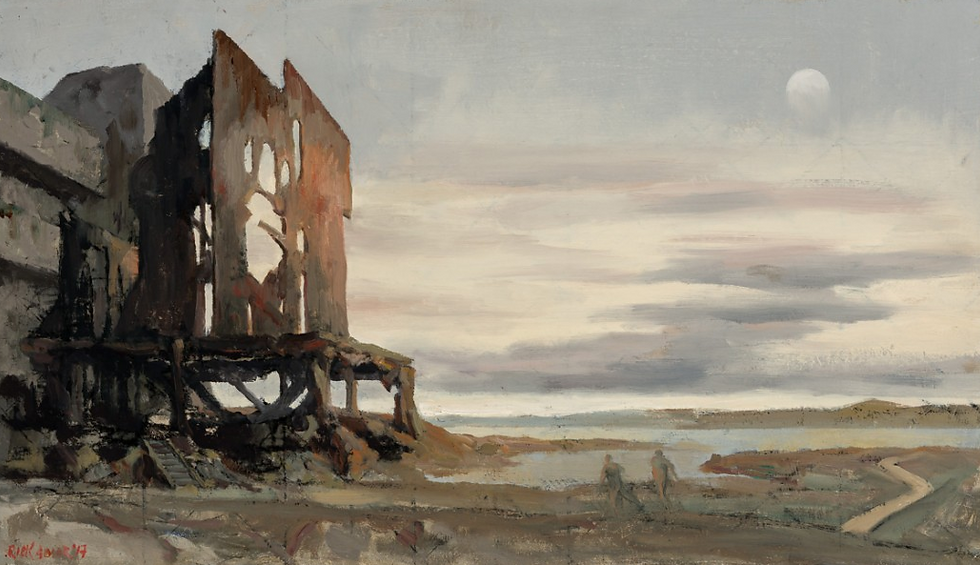
Rick Amor, 'Entering the city' (2017) Photo: Niagara Galleries

William Breen,'Shed, Coldstream' (2018) Photo: Flinders Lane Gallery
Chris Langlois
Since graduating from art school in 1990, the widely acclaimed Sydney artist Chris Langlois has fastidiously worked on expanding his practice and understanding of the changing natural environment that surrounds him. Langlois’ vast, atmospheric skies and seascapes to his realistic renderings of landscapes, both real and imagined, transcend time and space to become much more about personal experience.
Characterised by subtle shifts of light and space, Langlois explores the vastness of land and sea, enfolding the viewer in his deeper themes of melancholy and beauty. (Olsen Gallery, Sydney)
Jason Cordero
Cordero’s paintings have an unsettling, somewhat mythical presence. Dramatic landscape and elemental features, bordering at times on the surreal, curl into peculiar, half-familiar symbols. Cordero plays with theatrical storm skies and captures the overwhelming force of nature, reminiscent of Romantic traditions. Although not literal, there is a human presence in his works. One is left with the eerie feeling of trespassing through the artist’s narrative.
Kathryn Ryan
Kathryn Ryan brings a skilled hand of drawing to her delicately wrought paintings. Her favoured themes of dramatic coastlines and sweeping Western District pastures, with the familiar form of wind-beaten pine trees silhouetted in the dusk and twilight through dappled light, resonate. But to Ryan and to the viewer, much remains concealed within the shadows. This imagery acts as one “to accentuate what remains”, says Ryan, “and remind us of what is lost”.
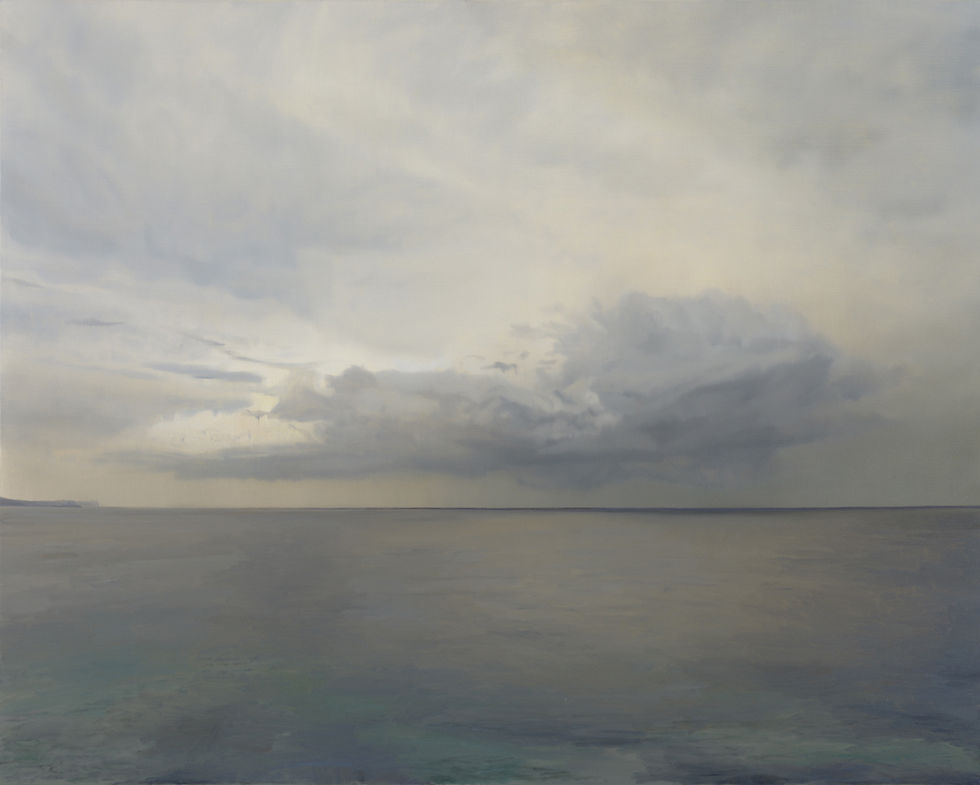
Chris Langlois, 'Ocean (Tasman Sea) no.3' (2013) Photo: Chris Langlois

Jason Cordero, 'Darkness of Day' (2012) Photo: Colville Gallery

Kathryn Ryan, 'Home Paddock' (2018) Photo" Flinders Lane Gallery
Sophia Szilagyi
Digital printmaker Sophia Szilagyi produces provocative and striking imagery, inspired by nature and employing a detailed process of layering to create depth. In capturing the beauty and grandeur found in the physical world, Szilagyi describes her work as charting “an internalised topography, giving form to unseen emotional and imaginative experience”.
Whilst the images are captivating, without the artist’s description one is left viewing the works from a somewhat isolated position. The redeeming feature here is that the works compel an emotional response from the viewer, delving deep into our own memories in order to reconcile with the artist’s theme.
Peter Daverington
Set against poetic landscapes, Peter Daverington’s paintings are reminiscent of the Romantic tradition. Daverington seamlessly weaves a wide range of otherwise clashing pictorial idioms in his works. For him, it is like looking at life from multiple viewpoints and capturing the way being human and life itself is a natural struggle between viewpoints, opinions and perspectives. (Art Collector, Issue 70 October 2014)
Philip Wolfhagen
Philip Wolfhagen is a talented and influential painter. His paintings are in my view one of the best embodiments in the Australian context of Romanticism. His works are as much an ecological elegy and eulogy as they are philosophical and intellectual. They are about loss of place. A loss that is both literal in that the landscapes and ecosystems around us are changing, and psycho-social because on a deeper level they can make you feel that we are losing our place in the world, that we are lost as to how to stem the destruction, heal the wounds and make amends. Our grieving is persistent but must in the end spur us on to act.

Sophia Szilagyi, 'Memory' (2013) Photo: Turner Galleries

Peter Daverington, 'The Valley' (2014) Photo: Peter Daverington

Philip Wolfhagen, 'A cruciform landscape' (2006) Photo: Bett Gallery
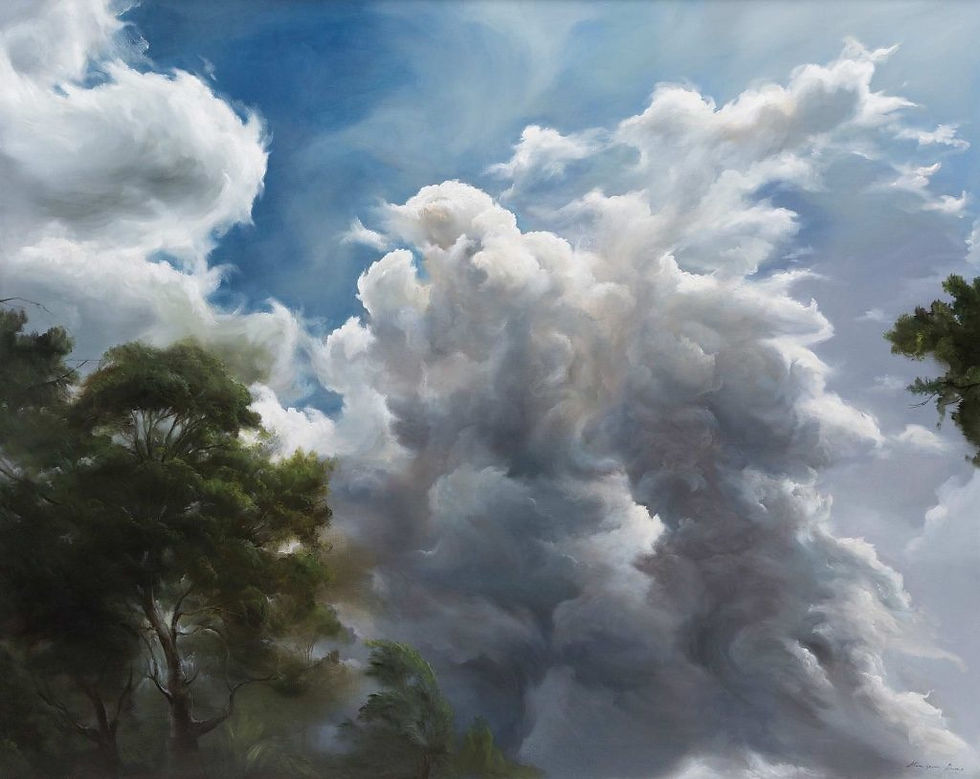
Min Woo Bang, 'Afterimage of Memory’ (2018) Photo: Mitchell Fine Art
Joanna Logue
Through intense observation, a narrow palette, solidity of shapes, and a painterly textural complexity Joanna Logue explores the landscape. Often anchored in one, familiar place, Logue curiously seeks out a more imaginative, natural idyll as a means of connecting with and understanding her own world.
For Logue, the interpretation of visual structure in the landscape she says becomes second nature, liberating the artist to layer a deep emotional, transformative response in the work. Central to Logue’s painting as she moves onto to a new life living and working in the north-eastern US State of Maine is her desire to grasp the degree to which our senses and hers as an artist are entwined with the landscape, and about how we evolve from a view of a particular place to the universal.
Tony Lloyd
Tony Lloyd is renown for his strong work ethic and a highly experimental approach to his art that such dedication permits. But it is the landscape, and particularly the human interaction with it, that underpins much of his work – exemplified by asphalt roads winding their way through the dark countryside, perhaps illuminated only by the headlights of a car, and where the viewer is thrust into the driver’s seat. We feel the road rushing toward us, passing under us, as if the world is rolling forward under our stationary bodies rather than us moving into it. (Kent Wilson, Artist Profile November 2014) In this way, Lloyd places the viewer at the apex of the painting, literally transported along with the artist into another world.
Min Woo Bang
And while Gregg does not reference Sydney-based artist Min Woo Bang, I feel it would be remiss to leave him out of this company. The artist here possesses an unrivaled ability to portray the sheer power of nature against an unsuspecting landscape, to highlight our vulnerability, and mortality and the fragility of our physical and indeed emotional connections.
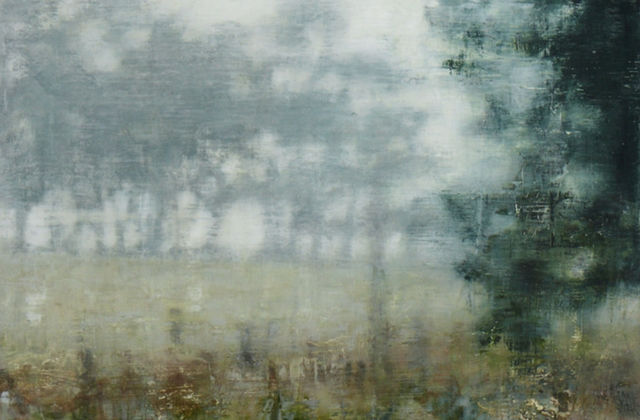
Joanna Logue, 'Hawthorns - Lake George' (2010) Photo: Joanna Logue

Tony Lloyd, 'The Other Way' (2014) Photo: Art Collector
The defining characteristics of Romanticism then remain at the heart of great landscape painting today. Artists aspiring to create great landscape art owe much to the Romantics, as without their imaginative response to the constraints of their socio-political environment, bending the conventions of the day, landscape painting and indeed other forms of art would be the poorer. There is a group of Australian artists defying fancy and misplaced romantic sentimentality and who can rightly claim their place at the forefront of contemporary art practice - purposefully continuing a long Romantic tradition, sensitively embracing its complexity, and perhaps stoking as they should the fires of controversy that will inevitably accompany them.
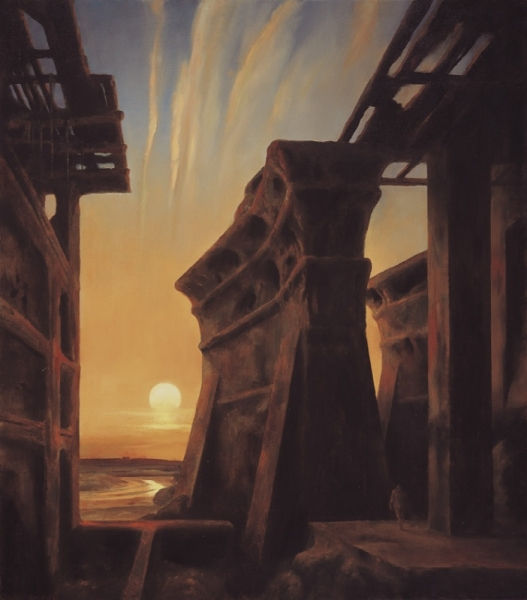
Rick Amor, 'World of Iron' (2004) Photo: Niagara Galleries

Tony Lloyd, ‘Deep in the Woods’ (2009) Photo: The Sydney Morning Herald
Main Photo: Rick Amor, 'Storm from the South' (2016) Photo: Niagara Galleries
Andrew McIlroy is a visual artist and arts writer, living and working in Melbourne, Australia



Comments